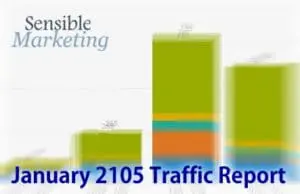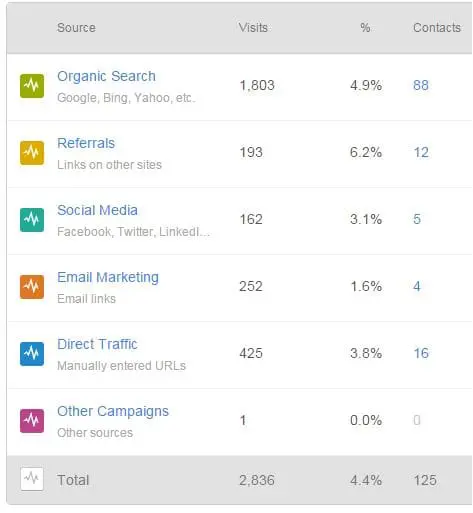 We spend hundreds of hours a month doing inbound marketing for ourselves and our clients. Keeping a close eye on the results of this effort is something we do for every client — and for our own marketing. Inbound marketing success is measured by a variety of metrics.
We spend hundreds of hours a month doing inbound marketing for ourselves and our clients. Keeping a close eye on the results of this effort is something we do for every client — and for our own marketing. Inbound marketing success is measured by a variety of metrics.
Every month I’ll share with you the results of our own marketing efforts, what’s working and what’s not, and some comments about our why we’re doing what we’re doing. This will usually be a mid-month report (of data from the previous month), but we’ll start with this late February report on our January results.
What was happening in January?
We merged the Sigma Web Marketing website (on HubSpot) and the Sensible Marketing website (WordPress) into a new site on HubSpot on January 3rd. Sigma had approximately 400 pages, all with search engine links. Alaniz was much smaller, with about 80 pages and search engine links.
Traffic
The new site went live on January 3rd, and we immediately setup 301 redirects with the search engines, so that the new pages could be found and people wouldn’t get 404 errors (page not found errors) when they clicked on a search engine link to go to our new site.
This switch-over to the new site was something I was very concerned about — I wanted to make sure we 1) kept our good search rankings, and 2) provided a good user experience for people who were searching for us.
You can see in the above stats that on Jan 3 we started rebuilding traffic, and the following weeks we maintained traffic above our previous level.
We continue to get significant organic traffic and published new blog posts almost every weekday through the month. We published 18 posts, which received 2,305 views.
 Here’s a look at our overall traffic for the month, which was just shy of our goal of 3,000 visitors.
Here’s a look at our overall traffic for the month, which was just shy of our goal of 3,000 visitors.

In addition to the volume of traffic, you’ll want to look at the sources of that traffic because some sources will produce much higher quality leads than others. The breakdown of the sources of our January traffic is below.

We see that our visitors are coming from a good variety of sources, which indicates that we’re doing a good job of promoting our content.
It’s notable that even with the new website, the high amount of organic traffic (from the search engines) is a significant sign that we were successful in our migration and redirect efforts, and that our blogging continues to bring in visitors. The impact of regular blogging compounds over time as those pages on our website get more and more traction in the search engines.
Converting visitors to leads
It’s great to have a growing amount of traffic, but how many of those visitors converted into leads? In January we grew our contact list by 125. As would be expected, the source of contacts parallels the sources of traffic as show here.

Of the 125 new contacts, 88 of them came from organic traffic. This is desirable because these visitors are actually looking for what we wrote about.This makes sense. . . when you search for something online, you usually assume that the top results are from thought leaders in their industry.
Summary and insights
Our efforts to build traffic to our new website were successful, and we had an outstanding overall visitor-to-conversion rate of 22%. That is remarkable, and primarily the result of a single top-of-the-funnel offer. We also had good traction with a more important offer that was highly targeted to one of our buyer personas.
- Retained search engine effectiveness when combining two websites into a new one.
- 2,836 visitors to the website
- 125 new contacts
- Our visitors are coming from a mix of traffic sources, and are likewise converting from a mix of sources as well.
- 63% of our traffic came from organic sources.
- We are now seeing the revenue results from January as we are closing new business opportunities in the latter half of February.





